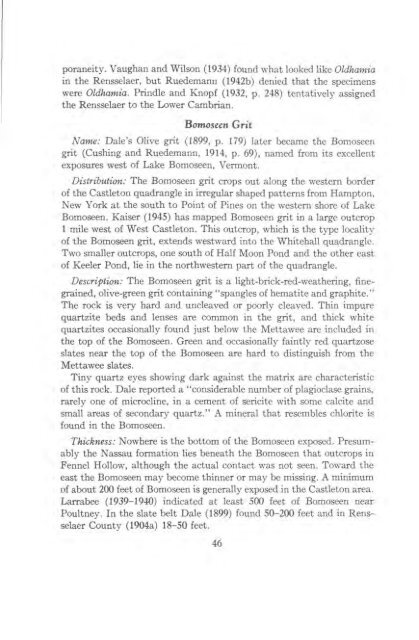STRATIGRAPHY AND STRUCTURE CASTLETON AREA VERMONT
STRATIGRAPHY AND STRUCTURE CASTLETON AREA VERMONT
STRATIGRAPHY AND STRUCTURE CASTLETON AREA VERMONT
Create successful ePaper yourself
Turn your PDF publications into a flip-book with our unique Google optimized e-Paper software.
poraneity. Vaughan and Wilson (1934) found what looked like Oldhamia<br />
in the Rensselaer, but Ruedemann (1942b) denied that the specimens<br />
were Oldhamia. Prindle and Knopf (1932, p. 248) tentatively assigned<br />
the Rensselaer to the Lower Cambrian.<br />
Bomoseen Grit<br />
Name: Dale's Olive grit (1899, p. 179) later became the Bomoseen<br />
grit (Cushing and Ruedemann, 1914, p. 69), named from its excellent<br />
exposures west of Lake Bomoseen, Vermont.<br />
Distribution: The Bomoseen grit crops out along the western border<br />
of the Castleton quadrangle in irregular shaped patterns from Hampton,<br />
New York at the south to Point of Pines on the western shore of Lake<br />
Bomoseen. Kaiser (1945) has mapped Bomoseen grit in a large outcrop<br />
1 mile west of West Castleton. This outcrop, which is the type locality<br />
of the Bomoseen grit, extends westward into the Whitehall quadrangle.<br />
Two smaller outcrops, one south of Half Moon Pond and the other east<br />
of Keeler Pond, lie in the northwestern part of the quadrangle.<br />
Description: The Bomoseen grit is a light-brick-red-weathering, finegrained,<br />
olive-green grit containing "spangles of hematite and graphite."<br />
The rock is very hard and uncleaved or poorly cleaved. Thin impure<br />
quartzite beds and lenses are common in the grit, and thick white<br />
quartzites occasionally found just below the Mettawee are included in<br />
the top of the Bomoseen. Green and occasionally faintly red quartzose<br />
slates near the top of the Bomoseen are hard to distinguish from the<br />
Mettawee slates.<br />
Tiny quartz eyes showing dark against the matrix are characteristic<br />
of this rock. Dale reported a "considerable number of plagioclase grains,<br />
rarely one of microcline, in a cement of sericite with some calcite and<br />
small areas of secondary quartz." A mineral that resembles chlorite is<br />
found in the Bomoseen.<br />
Thickness: Nowhere is the bottom of the Bomoseen exposed. Presumably<br />
the Nassau formation lies beneath the Bomoseen that outcrops in<br />
Fennel Hollow, although the actual contact was not seen. Toward the<br />
east the Bomoseen may become thinner or may be missing. A minimum<br />
of about 200 feet of Bomoseen is generally exposed in the Castleton area.<br />
Larrabee (1939-1940) indicated at least 500 feet of Bomoseen near<br />
Poultney. In the slate belt Dale (1899) found 50-200 feet and in Rensselaer<br />
County (1904a) 18-50 feet.<br />
46













